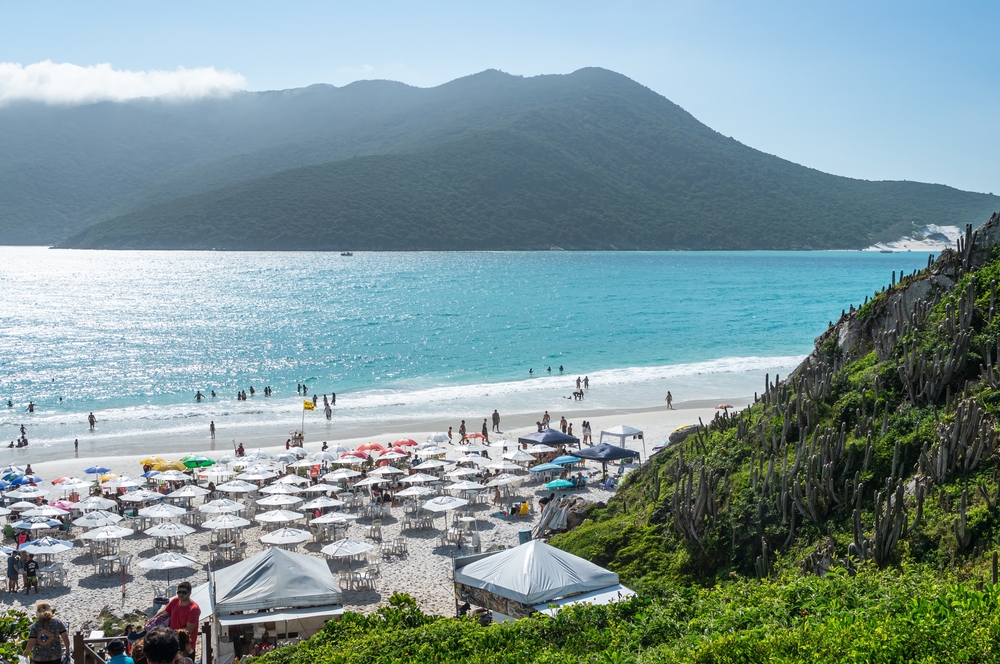Table of Content
ToggleIntroduction
Brazil is home to one of the most important breeding grounds for humpback whales. Each year, these majestic creatures migrate to the warm waters of the Abrolhos Bank to breed and calve. This journey is crucial for their reproductive success and the continued growth of their population.
The humpback whale population in Brazilian waters has been the focus of extensive study and conservation efforts. Conservationists and researchers work diligently to monitor their abundance and ensure their protection against threats such as ship collisions and entanglement in fishing gear. This research has been fundamental in understanding the whales’ patterns and behaviors.
Despite the challenges they face, humpback whales have shown remarkable recovery in Brazil. Scientific efforts have spotlighted the need for ongoing protection to safeguard these magnificent animals and their habitats. By continuing to support research and conservation, Brazil plays a vital role in the global efforts to preserve humpback whales.
Key Takeaways
- Brazil is a key breeding ground for humpback whales.
- Conservation efforts and research are crucial for their protection.
- Humpback whale populations are recovering in Brazil.
The Humpback Whale: An Overview
The Humpback Whale (Megaptera novaeangliae) is a fascinating marine mammal known for its unique physical traits and complex behaviors. These whales are commonly found in various oceans, including the coast of Brazil.
Physical Characteristics
Humpback whales are known for their robust build and long pectoral fins, which can reach up to one-third of their body length. They can grow up to 60 feet long and weigh around 40 tons.
Humpbacks have distinctive knobby heads and a series of bumps called tubercles. Their bodies are dark gray to black, with white patches on their undersides.
A layer of blubber helps maintain their body temperature in cold waters. Their tail flukes have unique patterns of pigmentation, which researchers use for identification.
Life Cycle and Behavior
Humpback whales give birth every two to three years, with a pregnancy lasting about 11 months. A newborn calf is around 13-16 feet long and weighs up to a ton at birth.
These whales are known for their long migrations, traveling thousands of miles between feeding and breeding grounds. In Brazil, the Abrolhos Bank is a key breeding area.
Humpbacks are also famous for their songs and acrobatic displays, including breaching and tail-slapping. These behaviors are believed to play roles in communication and mating.
Historical Context of Whaling
Whaling in Brazil began as early as the 17th century and took a significant toll on humpback whale populations. Legal protections and international agreements eventually shifted the course of whaling activities, aiming to conserve the species.
Impact of Commercial Whaling
Commercial whaling in Brazil was a major activity between the 17th and 19th centuries. Whaling was a royal monopoly starting from 1614, which meant the industry was controlled by the crown. This monopoly allowed extensive hunting, leading to the depletion of local whale populations.
Many whales, particularly humpbacks, were targeted for their blubber and oil. These products were highly valuable during that era and contributed significantly to the economy. The exploitation of whales resulted in notable reductions in whale populations, creating an ecological imbalance.
Legal Protections and International Agreements
By the mid-20th century, the international community began recognizing the need for whale conservation. The International Whaling Commission (IWC), established in 1946, played a critical role in setting quotas and advocating for whale protection.
Brazil joined these efforts, implementing stricter whaling regulations and agreeing to international norms. Notably, the hunting of humpback whales was significantly reduced. The legal protections in Brazil helped curb illegal whaling activities and supported whale population recovery.
In addition to national laws, international agreements further reinforced protections, making illegal whaling a serious offense. These measures collectively aimed to prevent the extinction of the species and restore ecological balance.
Humpback Whales in Brazilian Waters
Humpback whales are frequently seen along the Brazilian coast, especially in the Atlantic waters. Bahia and Abrolhos Bank are key areas due to their role as breeding and calving grounds.
Brazilian Coast as Breeding Grounds
The Abrolhos Bank in Brazil is the most important breeding ground for humpback whales in the South Atlantic. These waters attract whales for their warm, shallow conditions, ideal for calving and nursing.
Research indicates that humpback whales use this region extensively during breeding season. Additionally, the north coast of Bahia also serves as a breeding area, with sightings increasing over the years. This rise in sightings suggests a growing humpback whale population in Brazilian waters.
Migration Patterns
During their migratory journey, humpback whales travel thousands of miles to reach Brazilian waters. Their migration typically starts in the Antarctic, moving to the warmer climates near Brazil.
The region around the Trindade and Martim Vaz archipelago is a notable migratory route. Studies show frequent groups passing through, indicating its importance. Unlike their usual feeding grounds, these tropical waters offer different resources, sometimes leading to observed feeding behavior during their stay. This route highlights the critical nature of Brazilian waters for migrating humpback whales.
Conservation Efforts in Brazil
Brazil is home to significant conservation projects aimed at protecting humpback whales. Two prominent initiatives include Projeto Baleia Jubarte and the Baleia a Vista Initiative, both of which focus on preserving whale habitats and monitoring populations.
Projeto Baleia Jubarte
Projeto Baleia Jubarte, or the Humpback Whale Project, is a key marine conservation effort focused on the eastern coast of Brazil. This project primarily operates in the Abrolhos Bank region, which is a crucial breeding ground for humpback whales.
Founded in 1988, this project aims to conduct research, promote environmental education, and engage in conservation activities. It uses a combination of boat-based surveys and aerial observations to monitor whale populations. Over time, they have gathered a significant amount of data that aids in understanding the behavior and migration patterns of these whales.
Additionally, Projeto Baleia Jubarte plays a role in policy advocacy. By influencing regulations related to marine conservation, the project helps ensure that the humpback whales’ habitats are protected from threats like industrial activities and pollution.
Baleia a Vista Initiative
The Baleia a Vista Initiative works towards the conservation of humpback whales along the Brazilian coastline, especially in the state of Bahia. Similar to Projeto Baleia Jubarte, it focuses on research and public awareness.
This initiative gathers data on whale sightings and uses it to develop strategies for habitat protection. Public engagement through educational programs and community involvement is a significant aspect. They work with local communities to foster a sense of stewardship for marine life.
One of its notable features is the use of citizen science. Volunteers and local residents are trained to record whale sightings, contributing valuable data for research purposes. This participatory approach enhances data collection and builds community awareness about marine conservation.
Through these initiatives, Brazil continues to play a vital role in the global effort to protect and conserve humpback whales.
Scientific Research and Monitoring
Researchers and citizen scientists play important roles in understanding the population dynamics and distribution of humpback whales in Brazil. Different methods like photo-identification are critical for tracking these marine giants.
Role of Citizen Scientists
Citizen scientists contribute significantly by collecting data during whale watching tours and other activities. They help researchers gather information on whale sightings, behaviors, and even satellite-monitored movements. These volunteers are often trained to take clear photographs of humpback whales, capturing unique features like tail flukes.
This data collection assists in understanding migration patterns and population sizes. Programs like HappyWhale make it easier for citizen scientists to upload and share their photos. Their contributions are vital for supplementing scientific research, providing more comprehensive data for population dynamics studies.
Importance of Photo-Identification
Photo-identification involves taking detailed photographs of individual whales, mainly focusing on their tail flukes and dorsal fins. Each whale has unique markings, making it possible to identify and track them over time. This method is essential for studying the distribution and population size of humpback whales in Brazilian waters.
Researchers use these photographs to monitor whale health, migration routes, and breeding patterns. Citizen scientists also play a role here, contributing photos to databases like HappyWhale. This collaborative effort between professionals and volunteers ensures a more accurate and comprehensive understanding of the humpback whale population.
Population Trends and Recovery
Humpback whale populations in Brazil have shown remarkable progress in recent years. These trends highlight the population growth and breeding stock recovery.
From Endangerment to Recovery
Humpback whales off the coast of Brazil were once heavily exploited, leading to significant drops in their numbers. Strict conservation measures and a cessation of commercial whaling have allowed these populations to rebound. This recovery is evident from increased sightings and strandings.
Research indicates a rapid population growth, largely due to effective protective regulations. Genetics studies suggest a stable and diverse gene pool, critical for long-term recovery. Census data collected over the years present a clear picture of these whales gradually reclaiming their traditional wintering grounds.
Current Population Levels
Current estimates of humpback whales in Brazil’s breeding grounds show a steady rise. The most recent surveys highlight significant increases every year. These estimates are derived from standardized protocols and consistent data collection methods.
Sightings along the Brazilian coast, particularly near the Abrolhos Bank, confirm the resurgence of these marine giants. The consistency in these sightings is a strong indicator of recovering population levels. The continuous monitoring of breeding stocks further validates the success of conservation efforts in the region.
Genetic Diversity and Whale Populations
Research into the genetic diversity of humpback whales in Brazil is vital for conservation. This section discusses mitochondrial DNA analysis and the implications for conservation genetics.
Mitochondrial DNA Analysis
Mitochondrial DNA (mtDNA) analysis is a key method for studying humpback whales in Brazil. It reveals genetic variation and helps to track migration routes. Studies show high mtDNA diversity among whales in the Southwestern Atlantic, indicating a healthy breeding population. For example, whales migrating to Brazil every winter for breeding display significant intra-region variation in mtDNA sequences.
The mtDNA data also allows comparison with other populations. Analyzing the haplotypes from Brazil and other regions shows genetic links, aiding in understanding gene flow between populations. This is essential to determine the connectivity and independence of different breeding grounds, which helps in conservation efforts.
Implications for Conservation Genetics
The genetic differentiation among humpback whale populations provides insights into conservation strategies. Knowing the level of gene flow between populations helps in assessing their vulnerability to threats. High genetic diversity, as found in Brazilian humpbacks, generally indicates a robust population. This resilience is key for long-term survival.
Conservation genetics uses this information to protect unique genetic traits and manage breeding stocks. For example, the identification of distinct haplotypes can guide efforts to maintain genetic health. Preserving genetic diversity is crucial for adaptability to environmental changes, ensuring the sustainability of whale populations in the face of climate change and human impact.
Whale Migration and Seasonality
Humpback whales are known for their long migrations between breeding and feeding grounds. These movements are timed with the seasons to make the most of available resources.
Breeding Migration
Humpback whales in the Southern Hemisphere travel long distances to reach their breeding grounds. One key area is off the coast of Brazil, notably around the Abrolhos Archipelago. Here, whales gather to mate and give birth in warmer waters.
Breeding migration typically happens during the winter months. This allows newborn calves to develop in a safer, warmer environment. It is also thought that these warmer waters provide better conditions for the young calves to grow and learn essential survival skills.
Natal philopatry, where whales return to the area of their birth to breed, is common among humpback whales. This helps maintain population structure and ensures that suitable breeding habitats are reused each year.
Feeding Migration
Feeding migration sees humpback whales move from warmer breeding grounds to colder, high latitude feeding grounds. During the summer months, whales head towards regions rich in food like krill and small fish in the South Atlantic.
The high latitude feeding grounds provide an abundance of nutrients, essential for the whales to build up energy reserves. This accumulation of blubber is crucial for surviving the long migration back to the breeding grounds without eating much.
Feeding migrations involve covering thousands of miles and can be monitored through satellite tracking. The timing and routes of these migrations are predictable, showcasing the species’ reliance on seasonal changes for survival.
The Importance of International Collaborations
International collaborations are crucial for the conservation and study of humpback whales in Brazil. These efforts help monitor whale populations across vast ocean basins and ensure coordinated protection measures.
Cross-Boundary Conservation
Humpback whales travel across the South Atlantic and Southern Ocean, requiring coordinated conservation efforts between countries. For example, between Brazil and South Georgia, efforts have been documented to track and protect these whales. The International Whaling Commission facilitates agreements between nations to establish marine protected areas and regulate activities that impact whales.
Global Monitoring Efforts
Monitoring humpback whale populations globally is essential for understanding their behaviors and migration patterns. Using technologies like passive acoustics, researchers from different countries collaborate to gather comprehensive data. The creation of a Global Whale Watching Platform and data-sharing agreements enhance global research initiatives, allowing scientists to track whale populations across various ocean basins and polar regions effectively.
Challenges and Threats to Humpback Whales
Humpback whales in Brazil face numerous challenges including the effects of climate change and various human-induced threats. These stressors impact their habitats, health, and population strength.
Climate Change Impact
Climate change affects humpback whales by altering their marine ecosystems. Rising sea temperatures can shift the distribution of krill and other prey, making it harder for whales to find food.
Melting polar ice caps and ocean acidification also impact prey availability and quality. These factors can weaken whale populations, making them more vulnerable to other threats.
Changes in sea ice can disrupt migration patterns and breeding grounds. Humpback whales might struggle to navigate waters that were previously frozen or too warm. Addressing climate change is essential for the conservation of marine mammals like humpback whales.
Human-Induced Risks
Human activities pose significant risks to humpback whales. Ship strikes are a major concern, especially in busy marine traffic areas like the Brazilian coast. Humpback whales are often hit by ships, leading to serious injuries or death (source).
Fishing nets and gear can entangle whales, causing injury or drowning. Industrial activities such as oil and gas exploration also pose threats. Noise pollution from these activities can disrupt whale communication and navigation (source).
Efforts to protect humpback whales include creating marine protected areas and improving regulations on marine traffic. Conservation measures are crucial to mitigate these human-induced threats and ensure the survival of humpback whale populations.
Frequently Asked Questions
Humpback whales in Brazil are a significant topic due to their seasonal presence and the efforts made for their conservation. Here are key answers to common questions.
What is the best season for whale watching in Brazil?
The best season for whale watching in Brazil is between July and November. During these months, humpback whales migrate to warmer waters near the Brazilian coastline for breeding and calving.
Which areas are most popular for whale watching in Brazil?
The most popular areas for whale watching include the Abrolhos Bank, the coast of Bahia, and the Eastern Brazilian Coast. The Abrolhos Bank is particularly known for its vibrant humpback whale population during the breeding season.
What conservation efforts are in place for humpback whales in Brazil?
Brazil has several conservation measures to protect humpback whales. These include designated marine protected areas, research programs, and regulations that limit human activities like shipping and fishing in key habitats.
Can humpback whales be seen from Rio de Janeiro?
Humpback whales can be seen from the northern coast of the State of Rio de Janeiro. This region is part of their migratory route, and sightings are possible during migration seasons.
How has the humpback whale population changed in Brazil over the years?
The humpback whale population in Brazil has been increasing. Data shows an expanding distribution along the north coast of Bahia and other regions. Conservation programs are contributing to this positive trend.
What are the legal regulations surrounding whale watching tourism in Brazil?
Whale watching in Brazil is regulated to ensure minimal disturbance to the whales. Guidelines include maintaining a safe distance from the whales, limiting the number of boats, and specific rules on how tours are conducted to promote sustainable tourism practices.












